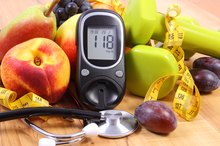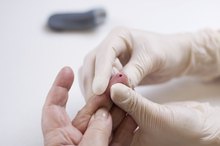What does fact checked mean?
At Healthfully, we strive to deliver objective content that is accurate and up-to-date. Our team periodically reviews articles in order to ensure content quality. The sources cited below consist of evidence from peer-reviewed journals, prominent medical organizations, academic associations, and government data.
- National Diabetes Education Program: The Facts About Diabetes: A Leading Cause of Death in the U.S.
- Academy of Nutrition and Dietetics: Diabetes and Diet
The information contained on this site is for informational purposes only, and should not be used as a substitute for the advice of a professional health care provider. Please check with the appropriate physician regarding health questions and concerns. Although we strive to deliver accurate and up-to-date information, no guarantee to that effect is made.
Advantages & Disadvantages of Diabetic Diets
Almost 26 million people in the United States have diabetes, according to the National Diabetes Education Program. Diabetes is a chronic illness characterized by high blood sugars. If left uncontrolled, diabetes can lead to other diseases such as heart or kidney disease, as well as an early death. Diet plays an important role in the treatment of diabetes. While there are a number of advantages to following a diabetic diet, there may be a few disadvantages for some people. Consult your doctor or dietitian to help you with your diabetic meal plan.
Advantage: Help With Blood Sugar Control
The primary goal in diabetes management is getting your blood sugar as close to normal as possible. Your doctor can help you determine your blood sugar goals, but in general, those numbers range from 90 to 130 milligrams per deciliter before meals and less than 180 milligrams per deciliter two hours after a meal. The carbohydrates you eat affect your blood sugar. A diabetic diet helps you control the amount of carbohydrates you eat each day and at each meal for better blood sugar management. Good blood sugar control may reduce your risk of diabetes-related complications.
- The primary goal in diabetes management is getting your blood sugar as close to normal as possible.
- A diabetic diet helps you control the amount of carbohydrates you eat each day and at each meal for better blood sugar management.
Advantage: Good for Weight Management
Can a Diabetic Eat Cottage Cheese?
Learn More
The diabetic diet is a healthy diet in general 1. The diet encourages you to eat a variety of foods from all the food groups, emphasizing fruits and vegetables, whole grains, lean sources of protein and low-fat dairy. The diet also encourages portion control and eating meals regularly. These healthy diet principles are the same recommendations given to someone who wants to lose weight. If you're overweight or obese and have diabetes, losing as little as 10 pounds can help improve blood sugar.
- The diabetic diet is a healthy diet in general 1.
- The diet encourages you to eat a variety of foods from all the food groups, emphasizing fruits and vegetables, whole grains, lean sources of protein and low-fat dairy.
Disadvantage: Too Rigid
The diabetic diet recommends you eat the same amount of food around the same time every day. Being consistent with the amount and timing of your meals aids in blood sugar control. Some people may have a hard time sticking to a rigid meal schedule. For example, if you are an emergency room nurse, you may have a difficult time eating meals at specified times. Additionally, not being able to eat the right amount of food at specified times can affect how your medication works, causing high or low blood sugars.
- The diabetic diet recommends you eat the same amount of food around the same time every day.
- Additionally, not being able to eat the right amount of food at specified times can affect how your medication works, causing high or low blood sugars.
Disadvantage: Too Complicated
Diet for People With Hyperglycemia
Learn More
While there is no one diabetic diet, there are two meal planning tools -- the exchange list and carbohydrate counting -- used to help people with diabetes eat better. The exchange list divides foods into groups based on similarities in nutritional content, and you are allowed a certain number of servings from each food group based on calorie needs and food preferences. Carbohydrate counting requires you count the number of carbs you eat at each meal and snack, sticking to a specific amount determined by your doctor or dietitian. Both plans require careful counting and measuring of what you eat 1. Some people may find either of these meal planning tools too complicated to follow.
- While there is no one diabetic diet, there are two meal planning tools -- the exchange list and carbohydrate counting -- used to help people with diabetes eat better.
- Carbohydrate counting requires you count the number of carbs you eat at each meal and snack, sticking to a specific amount determined by your doctor or dietitian.
Related Articles
References
Writer Bio
Jill Corleone is a registered dietitian and health coach who has been writing and lecturing on diet and health for more than 15 years. Her work has been featured on the Huffington Post, Diabetes Self-Management and in the book "Noninvasive Mechanical Ventilation," edited by John R. Bach, M.D. Corleone holds a Bachelor of Science in nutrition.









